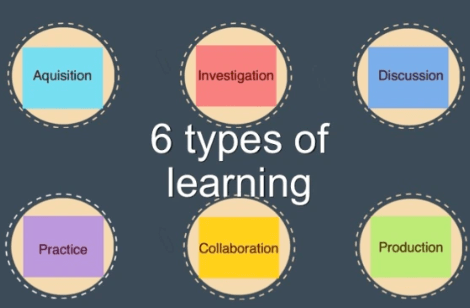Types of learning styles and techniques

 Learning is the process by which every human being assimilated knowledge and information received through the senses. Concepts, skills, values, attitudes can be learned. The three basic types of learning styles are visual learning style, auditory learning, and kinesthetic learning.
Learning is the process by which every human being assimilated knowledge and information received through the senses. Concepts, skills, values, attitudes can be learned. The three basic types of learning styles are visual learning style, auditory learning, and kinesthetic learning.
Learning occurs throughout human development and covers different aspects of the person. In children and young people, learning is promoted from school and home. Human beings learn through their own and others’ experiences and are helped by interaction with their peers and with the environment that surrounds them.
The different learning types are studied and classified according to currents of psychology and psychopedagogy. They can be classified according to the channel (visual, auditory, or kinesthetic) and according to the internal process that each person develops when relating to their peers and the environment.
Types of learning
- Memory or repetitive learning. A type of learning characterized by constant repetition. Through this method, attempts are made to locate knowledge in long-term memory. For example the study of the alphabet.
- Significant learning. Type of learning in which knowledge is related to another already existing in the subject. Use is made of the prior knowledge that each person possesses. For example: applying the multiplication tables when shopping at the supermarket.
- Maintenance learning. Type of learning that is based on a pattern or standardization of behavior. That is, the subject repeats a certain methodology repeatedly that is productive. For example: learning to use a study method that is useful.
- Innovative learning. Type of learning that is close to creative learning. Through this, the person tries to produce evaluative judgments and establish learning routes for the development of behaviors based on the development of their different abilities. For example: teaching a battle by visiting a history museum.
- Visual learning. Type of learning that uses images, cardboard, or film. It is usually very useful to reinforce other types of learning. For example: learning through interactive videos.
- Auditory learning. Type of learning in which knowledge is assimilated through active listening. It is often combined as a reinforcement of visual or other learning. For example: learning a language.
- Learning by discovery. Type of learning in which it is proposed that each subject receives the content and actively prepares responses. For example l l evar a child on a field trip to that based on his observation make a fantastic story.
- Responsive learning. Type of learning in which the subject receives new information but must not carry out any type of own elaboration. It is a type of receptive but passive learning at the same time since it does not require deep cognitive elaboration by the person. For example: reading a book.
- Associative learning. Type of learning in which the person establishes a link or associates two phenomena or certain situations, which allows him to act on the basis of this knowledge. For example, the child learns from experience that if he does not study he will get bad grades.
- Cooperative learning. Type of learning in which students work in groups or teams. There, information and opinions are exchanged by all members, this encourages the development of recreational and social skills. For example group chemical experiment.
- Experiential learning. Type of learning in which the person can use their experience or that of others to guide their actions. For example: learning from other people’s mistakes.
- Explicit learning. Type of learning in which the person is consciously receiving certain information is willing to learn and puts all their attention into acquiring knowledge. For example: listening to a master class by a writer.
- Implicit learning. Type of learning that occurs spontaneously, generally without realizing that you are facing learning. For example, a child when he learns to walk.
Examples of Types of learning
Rote or rote learning
- Multiplication tables
- Homeland dates learning
- The teaching of laws or the Constitution.
- Names of heroes
- Alphabet letters
Significant learning
- To understand a history text, it is necessary to know the language of origin.
- For the realization of multiplication, it is necessary the assimilation of the multiplication tables.
- To correctly interpret a melody, knowledge of the musical language is necessary.
- Knowledge of sign language is necessary to communicate with a deaf or hard of hearing person.
Maintenance learning
- Preparation of synoptic tables.
- Preparation of summaries.
- Preparation of comparative tables.
- Mnemonic rules that facilitate the understanding of a certain topic.
Innovative learning
- Knowledge of a chemical formula by experimentation.
- Assimilation of the different geographical faults by experience or knowledge of them through photographs.
- Calculation of water from a source by observation.
Visual learning
- Oral exhibitions with cardboard.
- Comic strips without text where a sequence of events is proposed.
- Mental maps
- Audiovisual presentations
- Videos
Auditory learning
- Use of onomatopoeias to learn the sounds of animals.
- Learn to play a musical instrument.
- Teaching words with their corresponding phonemic separation to understand each syllable or the accentuation of said word.
Responsive learning
- Solving mathematical problems.
- Attend conferences or forums.
- Reading textbooks.
Cooperative learning
- Group work
- Discussions
- Production of an audiovisual short film.
- More examples in Learning techniques